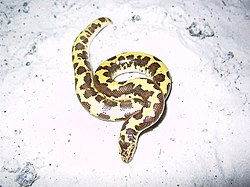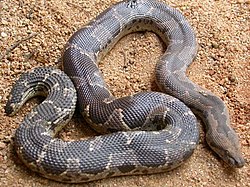Gongylophis
| Gongylophis | |
|---|---|

| |
| G. conicus, rough-scaled sand boa | |
| Scientific classification | |
| Kingdom: | Animalia |
| Phylum: | Chordata |
| Class: | Reptilia |
| Order: | Squamata |
| Suborder: | Serpentes |
| Family: | Boidae |
| Subfamily: | Erycinae |
| Genus: | Gongylophis Wagler, 1830 |
| Synonyms[1] | |
| |
Common name: sand boas
Gongylophis is a genus of non-venomous snakes in the family Boidae. The genus is endemic to Africa and the Indian subcontinent. Three species are recognized as being valid.[2] The species are still considered a category placed in the genus Eryx.
Distribution and habitat[]
The genus Gongylophis is found in Africa from Mauritania and Senegal east to Egypt and south to Tanzania. It is also reported from the southern tip of the Arabian Peninsula. In the Indian subcontinent the genus is found from eastern Pakistan, eastern India and Bangladesh southwards as far as northwestern Sri Lanka. To be more specific, the genus Gongylophis can be found in Egypt, Sudan, Ethiopia, Eritrea, Kenya, Chad, Niger, Yemen, Tanzania, and Somalia.[1]
Reproduction[]
Viviparous, oviparous; Sand boas reach sexual maturity at two to three years of age. Two of these snake species are ovoviviparous (young develop inside egg sacs incubated inside the female's body). The young hatch live after a gestation period of four months inside the female's body. She gives birth to five to 12 offspring. The young are completely independent at birth.[3] Sand boas are sexually dimorphic. Fully developed female sand boas can have a length of 26 to 32 inches long, while fully developed male sand boas can have a length of 15 to 18 inches long. Another important characteristic to note about their reproduction is their weight. More than their length, their weight is an indicator of good health and readiness for reproduction. The average healthy weight of a male sand boa ready to breed is 70 to 100 grams. The average weight of a healthy female sand boa ready to breed is 400-900 grams. Female sand boas give live birth from 5 to 12 offspring. The young sand boas are left to fend for themselves like most newly born reptiles.[3][4]
Behavior[]
Contrary to common belief, sand boas do not spend most of their time buried under loose dry sand. Sand boas are nocturnal and spend most of the day, when it is the hottest, hiding in semi-humid dirt or sand, burrowing to protect themselves and avoid common predators. Sand boas will climb, explore, and spend most of their time in long grass, shrubs, and bushes searching for small rodents or small birds. Sand boas are ambush predators. They hide, strike when they are stimulated by smell and movement, and coil to constrict their prey. Like most snakes, they swallow their prey whole and feed approximately once a week in captivity. Sand boas are docile small-sized boas that rarely strike in an aggressive or defensive manner, preferring to dig and burrow as a defense mechanism.[3]
Species[]
| Species[2] | Taxon author[2] | Common name | Geographic range[1] |
|---|---|---|---|
G. colubrinus
|
(Linnaeus, 1758) | Kenyan sand boa | Northeastern Africa [5] from Egypt as far west as Niger (Aïr), including Somalia, Ethiopia, Sudan, Kenya, and northern Tanzania. A single specimen has been reported from Yemen. |
G. conicus
|
(Schneider, 1801) | rough-scaled sand boa | Eastern Pakistan, India south of approx. 30° N, as well as the northern arid region of Sri Lanka. |
| G. muelleri | Boulenger, 1892 | Saharan sand boa | Africa along the southern edge of the Sahara, from Mauritania, Senegal and Sierra Leone, eastwards through Burkina Faso, Ghana, Togo, Benin, Nigeria and Chad to eastern Sudan. |
T) Type species.[1]
Taxonomy[]
Boulenger (1890) used the generic name Gongylophis for the Indian species, conicus, and Eryx for the other African and Asian species.[1]
References[]
- ^ a b c d e McDiarmid RW, Campbell JA, (1999). Snake Species of the World: A Taxonomic and Geographic Reference, Volume 1. Washington, District of Columbia: Herpetologists' League. 511 pp. ISBN 1-893777-00-6 (series). ISBN 1-893777-01-4 (volume).
- ^ a b c "Gongylophis ". Integrated Taxonomic Information System. Retrieved 23 November 2007.
- ^ a b c "Kenyan Sand Boa | Utah's Hogle Zoo". hoglezoo.org. Retrieved 2 June 2019.
- ^ Species Eryx colubrinus at The Reptile Database www.reptile-database.org.
- ^ Huntley, Mark (2012). SandBoaMorph.com’s East African Sand Boa Care Guide. CreateSpace Publishing. 36 pp. ISBN 1481003429. ISBN 978-1481003421
Further reading[]
- (1989). "Revision of genus Eryx (Serpentes: Boidae), osteological evidence". Vestnik Zoologii, Kiev 4: 46–55. (Neogongylophis, new subgenus). (in Russian).
- Wagler J (1830). Natürliches System der AMPHIBIEN, mit vorangehender Classification der SÄUGTHIERE und VÖGEL. Ein Beitrag zur vergleichenden Zoologie. Munich, Stuttgart and Tübingen: J.G. Cotta. vi + 354 pp. + one plate. (Gongylophis, new genus, p. 192). (in German and Latin).
External links[]
| Wikimedia Commons has media related to Gongylophis. |
- Gongylophis at the Reptarium.cz Reptile Database. Accessed 23 November 2007.
- Gongylophis
- Snake genera
- Taxa named by Johann Georg Wagler